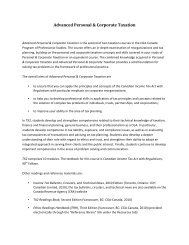Financial Accounting: Liabilities & Equities (FA3) Exam Review
Financial Accounting: Liabilities & Equities (FA3) Exam Review
Financial Accounting: Liabilities & Equities (FA3) Exam Review
You also want an ePaper? Increase the reach of your titles
YUMPU automatically turns print PDFs into web optimized ePapers that Google loves.
<strong>FA3</strong> <strong>Exam</strong> <strong>Review</strong> notes Barbara Wyntjes, CGA, MBA, B.Sc.<br />
Solution:<br />
a. (7 marks)<br />
To: Kerri Martinsky, CEO<br />
From: Zhang Chen, Assistant Controller<br />
Date: June 12, 2008<br />
Re: Ratio comparison with Plastic Ltd.<br />
(1) i) From a liquidity view, Polly appears to be quite liquid in 2007, compared with<br />
Plastic (quick ratio).<br />
(1) The receivables turnover and inventory turnover are significantly better than Plastic’s,<br />
indicating good management over this area.<br />
(1) This results in Polly having an overall better liquidity position than Plastic. There<br />
appears to be no concerns in this area; however, this is not to say improvements could not<br />
be made.<br />
(1) ii) From a profitability view, the return on assets and equity is very good, indicating<br />
that Polly is a well-managed and profitable business.<br />
(1) However, it should also be noted that Plastic is increasing its fixed assets and longterm<br />
debt, while Polly is not. Depending on the nature of these capital asset (for example,<br />
improved efficiency), this could cause concern in the future.<br />
(1) Also, Polly’s ROA is higher because it has a smaller asset base as a result of not<br />
investing in capital assets as much as Plastic has in the past 2 years.<br />
(1) We should investigate the decline of Polly’s gross margin, and attempt to reverse this<br />
trend. We should also reconsider Polly’s capital asset financing policy. The company has<br />
the capacity for additional long-term debt, which would provide leverage to further<br />
improve return on equity, and potential strategic advantages if invested in the correct<br />
assets.<br />
Note:<br />
3 marks for liquidity discussion; 3 marks for profitability discussion; 1 mark for areas of<br />
concern (lack of capital asset investment or gross margin decline)<br />
b. (1 mark)<br />
Plastic’s long-term debt is higher than Polly’s because Plastic is likely financing the<br />
purchase of capital assets with debt.<br />
3






